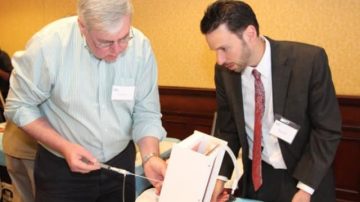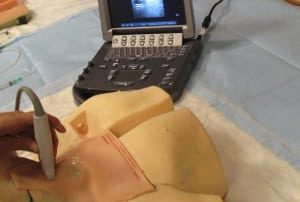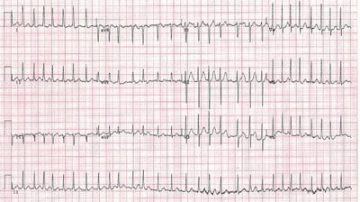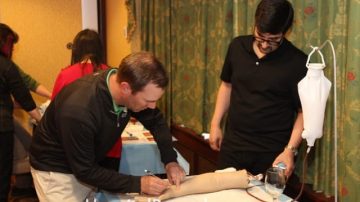Where to place a central venous catheter is a decision driven mainly by individual preference. The limited evidence available has not established any site as superior; the subclavian position has been reported as being less infection-prone, but more likely to cause…
Read MoreA study from an urban EM residency program determined that in-plane ultrasound-guided central venous catheterization is superior to out-of-plane ultrasound-guided central line placement. This study was only a single center study that was a randomized crossover study of ER residents…
Read MoreMore Tags – central lines, central venous catheters, featured, femoral lines, HPC updates, IJ lines, subclavian lines
The internal jugular or subclavian veins have fewer combined mechanical or infectious complications for central venous catheter insertions compared with femoral vein CVC placements. Numerous organizations have proposed guidelines or central line bundles that have advocated preferential use of the…
Read MoreHow do we assess a cirrhotic patients bleed risk prior to a planned bedside procedure? Can our standard platelet count and coagulation studies, prothrombin time (PT/INR) and partial thromboplastin time (aPTT), accurately predict bleed risk in cirrhotic patients? The quick…
Read MorePoint-of-care ultrasound is one of the most rapidly evolving areas of medicine. In addition to becoming the “stethoscope of the future” for bedside diagnostic evaluations, ultrasound has improved the safety and efficiency of a wide range of procedures. The use…
Read MoreThe evidence base for the safety of ultrasound-guided central line placement with thrombocytopenia or in patients with a bleeding diathesis is not robust. Nevertheless, based on the data available most procedural experts feels that an ultrasound-guided central venous catheter insertion…
Read MoreMore Articles – Central line, Featured Procedure, medical procedures, Ultrasound-Guided Peripheral IV
Safety checklists have been adopted by numerous industries to prevent errors and save lives. Checklists have been used for decades by industries as diverse as the aviation industry, construction companies, and professional chefs to prevent mistakes. In medicine, checklists have…
Read MorePrior studies have found that in patients with cryptogenic ischemic strokes, extended post-stroke cardiac monitoring detects intermittent atrial fibrillation (AF) in up to 20% of cases. Now, an industry-sponsored study from Germany randomized 400 patients all over 60 years old…
Read MoreDefinitions Presumed source with SIRS criteria = infection Infection with life-threatening organ dysfunction = sepsis Sepsis refractory to intravenous fluid challenge = septic shock Treatment of sepsis or septic shock Draw blood cultures x 2 Analyze any fluid that may…
Read MoreBoth the fractional excretion of sodium (FENa) and the fractional excretion of urea (FEUrea) have an established role as part of the work-up for determining if acute kidney injury (AKI) is due to a prerenal or intrarenal cause. Although both…
Read MoreMore Articles – Arterial line, Cardiovascular diseases, Central line, Infections, medical procedures
Arterial line-associated bloodstream infections occur at rate of 0.9-3.4 infections per thousand catheter-days. This rate of infections is similar to the risk of central line-associated bloodstream infections (CLABSIs). The CDC guidelines for arterial line placement recommend the use of chlorhexidine…
Read MoreThe goal of zero device-related infections is what CMS desires for all hospitals, but is not a realistic goal. Nevertheless, we can do everything in our power to minimize central line-associated bloodstream infections (CLABSIs). We now can appreciate that the…
Read MoreMore Articles – Arterial line, Central line, Chest Tube, Emergency Procedures, Endotracheal Intubation, FAST Exam, Glidescope Intubation, Hospital Procedures, King Tube, Lumbar Puncture, Medical General, medical procedures, Needle Decompression, Paracentesis, RUSH Exam, Thoracentesis, Ultrasound-Guided Peripheral IV
Hospitalists are in the ideal position to perform bedside procedures on their patients. They know every aspect about their patients and have had the opportunity to develop a good rapport and the trust of their patients. So, why are they…
Read MoreTranexamic acid is a simple little molecule, just a synthetic derivative of the amino acid lysine. But it’s also a potent pro-hemostatic drug that binds plasminogen and plasmin and stops the degradation of fibrin (the stuff in blood clots). Now…
Read MoreNeedle decompression location Traditionally, needle decompression for the emergent treatment of a tension pneumothorax is the second intercostal space in the mid-clavicular line. This remains an option for needle insertion when you are treating a tension pneumothorax. This insertion point…
Read MoreCategories
- ACLS (1)
- Arterial line (33)
- Cardiovascular diseases (77)
- Central line (55)
- Chest Tube (39)
- Dermatology (4)
- Emergency Procedures (139)
- Endocrinology (6)
- Endotracheal Intubation (36)
- Events (24)
- FAST Exam (12)
- Featured (113)
- Featured Procedure (42)
- Gastrointestinal diseases (32)
- Ginecology (3)
- Glidescope Intubation (21)
- Hematology (33)
- Hospital Procedures (85)
- Infections (32)
- Intraosseous line (8)
- King Tube (27)
- Laryngeal Mask Airway (18)
- Lumbar Puncture (36)
- Mechanical Ventilation (34)
- Medical General (95)
- medical procedures (258)
- Needle Decompression (6)
- Nephrology (11)
- Neurological diseases (12)
- Oncology (4)
- Paracentesis (32)
- Pericardiocentesis (3)
- Procedural Sedation (19)
- Respiratory diseases (85)
- RUSH Exam (8)
- Thoracentesis (37)
- Traumatology (24)
- Travel (27)
- Ultrasound-Guided Peripheral IV (13)












